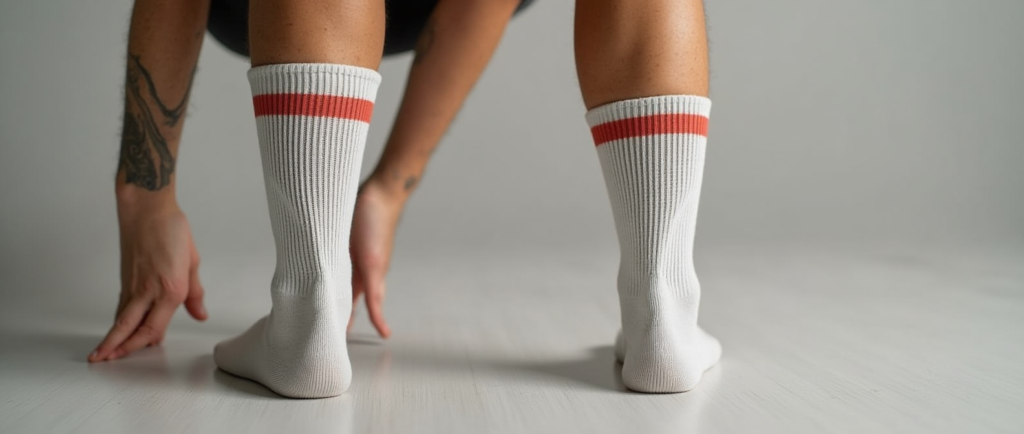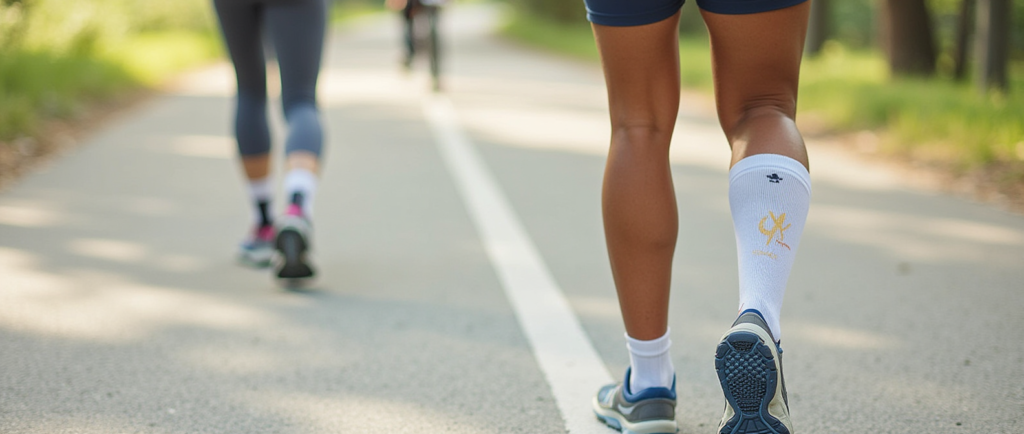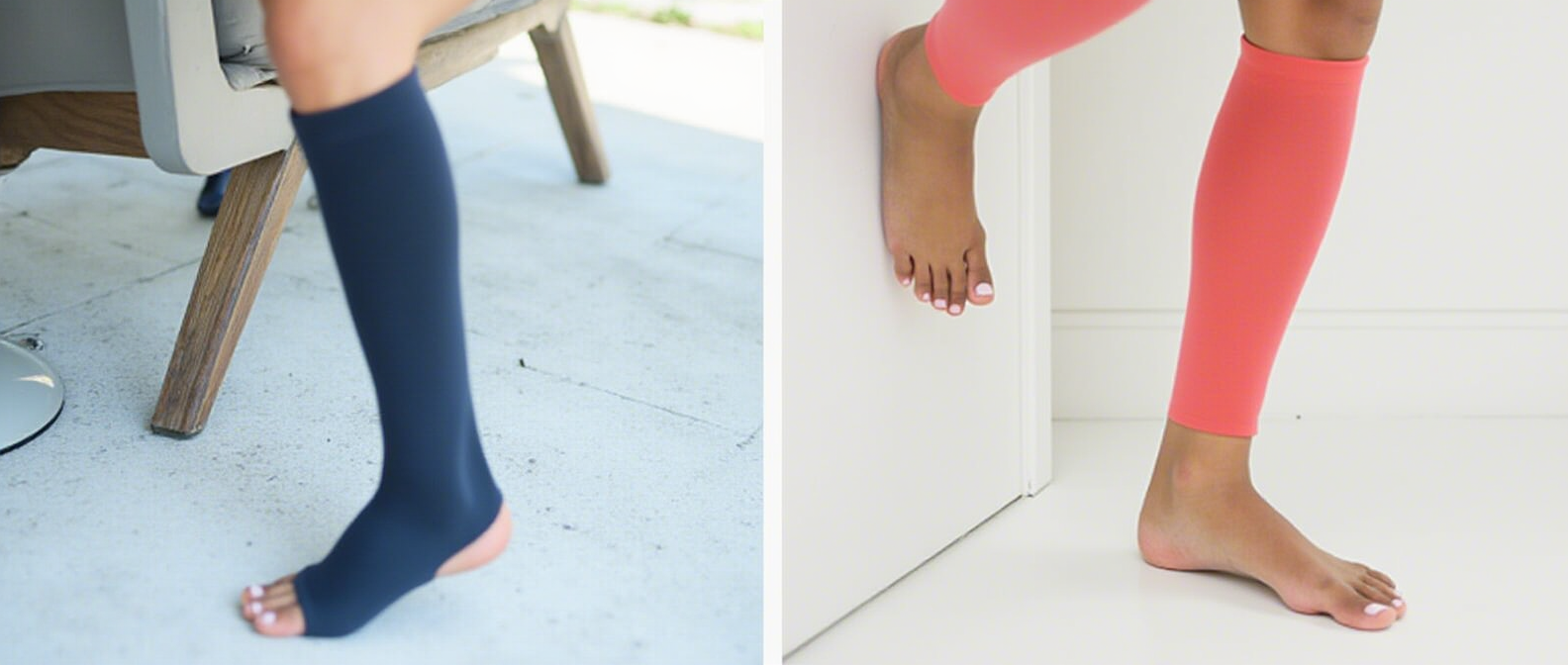If you’re into sports or stay active, you might know the pain of shin splints. This injury can stop you from working out, ruining your plans and lowering your game. But, is there a way to ease this pain? Maybe compression socks could help?
Table of Contents
Understanding Shin Splints: Causes and Symptoms
Shin splints, also known as medial tibial stress syndrome, are a common injury in runners and athletes. They cause pain and discomfort in the front of the lower leg, especially when moving. Knowing the causes and early signs is key to preventing and managing shin splints.
Common Risk Factors for Shin Splints
- Sudden increase in training intensity or duration
- Improper or worn-out footwear
- Running on hard or uneven surfaces
- Muscle imbalances or weakness in the lower body
- Overtraining and lack of rest and recovery
Recognizing Early Warning Signs
The first signs of shin splints include dull pain in the lower leg, tenderness, and swelling. As it gets worse, the pain can become more severe, especially during or after exercise. Ignoring these signs can lead to more damage and longer recovery times.
Impact on Athletic Performance
Shin splints can greatly affect an athlete’s ability to train and perform well. The pain and discomfort can limit movement, reduce endurance, and make it hard to keep up the intensity and duration of workouts. If left untreated, shin splints can also lead to more serious injuries, like stress fractures, which can further harm athletic performance.
| Cause | Symptom | Impact |
|---|---|---|
| Overuse injuries | Dull, achy pain in the lower leg | Reduced mobility and endurance |
| Improper footwear | Tenderness and mild swelling | Increased risk of more serious injuries |
| Muscle imbalances | Intense pain during and after activity | Compromised athletic performance |
By understanding shin splints, athletes and active people can take steps to prevent and manage this injury. This helps them stay fit and continue their sports without interruptions.


How Compression Socks Work for Pain Relief
Compression-socks are a popular choice for easing shin splint pain, a common injury in runners. Their secret is graduated compression. These socks apply gentle pressure, with the most pressure at the ankle and less as you go up the calf.
This pressure helps improve blood circulation by pushing deoxygenated blood back to the heart. It also cuts down on inflammation and boosts oxygen and nutrient delivery to muscles. Compression-socks support the muscles and tendons in the lower leg, reducing muscle fatigue and soreness during and after exercise.
- Enhances blood circulation for improved nutrient and oxygen delivery
- Reduces inflammation and swelling in the lower leg
- Provides muscle support and stability to prevent further injury
- Accelerates the recovery process by aiding in the removal of lactic acid
These benefits make compression-socks a great tool for managing shin splint pain. They help athletes and active people keep up with their training and stay active.
Will Compression Socks Help Shin Splints: The Science Behind It
Shin splints can be a big problem for athletes and active people. But, research shows that compression-socks might help solve this issue. Studies have found that compression therapy can effectively treat shin splints by addressing its causes.
Blood Flow and Circulation Benefits
Compression socks help shin splints by improving blood flow and circulation. Compression therapy research shows that these socks increase venous return. This leads to better oxygen and nutrient delivery to the muscles in the lower leg.
This increased blood flow helps reduce inflammation and speeds up recovery. It also eases the pain caused by shin splints.
Muscle Support and Stability Features
Sports medicine studies emphasize the role of muscle support and stability in treating shin splints. Compression socks offer targeted support to the lower leg muscles. They help reduce muscle movement and stress on the tibia during exercise.
This support can improve performance and prevent injuries. So, compression socks are a valuable tool for managing shin splints.
Recovery Time Improvements
Compression socks also help with faster recovery from shin splints. They provide compression and support that reduces muscle fatigue and soreness. This allows athletes and active people to get back to their activities sooner.
This is especially helpful for those who want to keep up their fitness without long breaks due to injury prevention.
In summary, the science backs up using compression socks for shin splints. They address the underlying issues, offer relief, and speed up recovery. This makes them a great choice for those dealing with this common injury.

Choosing the Right Compression Socks for Shin Splints
Finding the right compression socks for shin splints can really help. But, with so many options, it can feel overwhelming. Let’s look at the important things to think about when picking compression socks for shin splint relief.
The first thing to consider is the compression level. Socks come in different levels, from 15-20 mmHg (mild) to 30-40 mmHg (firm). For shin splints, a moderate level of 20-30 mmHg is usually recommended. It offers the right amount of support and blood flow without being too tight.
The material of the socks is also key. Look for breathable, moisture-wicking fabrics like nylon, spandex, or merino wool. These keep you cool and prevent skin irritation while you’re active. Cotton socks are not a good choice because they can get heavy and uncomfortable when wet.
Finding the right size is essential for effective compression. Make sure to measure your calf and foot and check the brand’s size chart. Socks that are too tight can cut off blood flow, while those that are too loose won’t offer enough support.
There are many good brands for compression socks, especially for shin splints. CEP, Zensah, and Feetures are well-known for their quality and comfort. Athletes and fitness fans often recommend these brands.
The best compression socks for shin splints are those that balance support, comfort, and breathability. Try out different styles and brands to find the perfect fit. This will help ease your shin splint pain and support your active lifestyle.
Best Practices for Wearing Compression Socks During Exercise
To get the most out of compression socks for shin splints, follow the right usage tips. It’s key to get the fit right. Socks that are too tight can cut off blood flow. On the other hand, those that are too loose won’t offer enough support.
Proper Fitting Guidelines
When picking compression socks, check the size chart carefully. Measure your calves and ankles to get a snug but comfy fit. The socks should feel firm but not too tight. You should be able to slide your fingers between the sock and your skin easily.
Duration and Timing Recommendations
Wear your compression socks during your workout and for at least 30 minutes after. This boosts blood flow, cuts down on swelling, and helps muscles recover. Start with 30 minutes and increase as your body gets used to the compression.
Maintenance and Care Tips
To keep your compression socks working well and lasting long, follow the washing guide from the maker. Usually, this means washing in cold water by machine and air drying. Taking good care of them ensures they keep supporting you during your workouts.
FAQ
What are the benefits of compression socks for shin splint relief?
Compression socks help with shin splints by improving blood flow and supporting muscles. They also reduce swelling, which can ease pain and speed up healing.
How do compression socks work to alleviate shin splint symptoms?
Compression socks apply pressure that boosts blood flow and supports leg muscles. This helps reduce swelling and pain, aiding in faster recovery.
What are the key features to look for when selecting compression socks for shin splints?
When picking compression socks for shin splints, look at the compression level, materials, and fit. These ensure the socks support and comfort your legs during activity.
How long should compression socks be worn for shin splint relief?
The time to wear compression socks for shin splints varies. But, wearing them during and after exercise helps support recovery.
Are there any specific considerations for using compression socks during exercise with shin splints?
Wearing compression socks during exercise needs careful consideration. Make sure they fit right, don’t overdo it, and follow the maker’s advice to avoid discomfort or injury.
Can compression socks help prevent shin splints from occurring in the first place?
Compression socks are mainly for treating shin splints. But, they can also help prevent them by supporting muscles and improving blood flow during activity, lowering injury risk.
Are there any potential drawbacks or risks associated with using compression socks for shin splint relief?
Most people find compression socks safe. Still, talk to a doctor, especially if you have health issues, to make sure they’re right for you.

